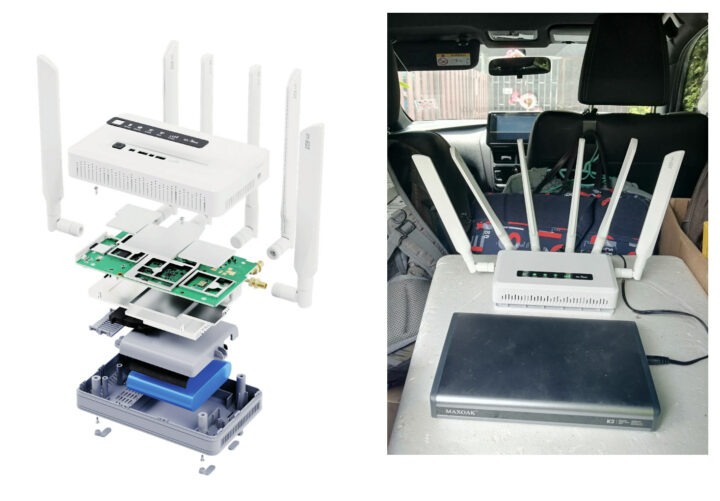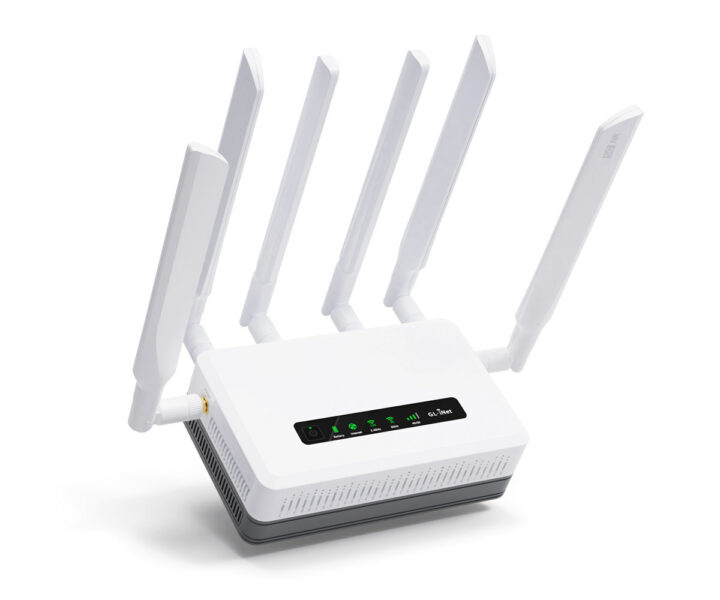GL.iNet Puli AX (also known as GL-XE3000) is a WiFi 6 and 5G cellular router with an integrated 6,400 mAh battery and running a fork of OpenWrt 21.02 on a MediaTek Filogic 820 dual-core Arm Cortex-A53 router SoC.
If the design looks familiar it’s because it’s based on the same platform as the GL.iNet Spitz AX 2.5GbE, WiFi 6 and 5G cellular router that we reviewed last May, except the new Puli AX model comes with a 6,400 mAh which makes it even more convenient as a travel router.
Puli AX (GL-XE3000) specifications:
- SoC – MediaTek MT7981A (Filogic 820) dual-core Arm Cortex-A53 processor @ 1.3 GHz
- System Memory – 512 MB DDR4
- Storage – 8GB eMMC flash, MicroSD card slot
- Networking
- 1x 2.5GbE WAN Ethernet port
- 1x Gigabit Ethernet LAN port
- Dual-band IEEE 802.11a/b/g/n/ac/ax WiFi 6 up to 574Mbps (2.4GHz), 2,402Mbps (5GHz)
- RM520N-GL 5G cellular modem and 2x Nano SIM card slots with support for failover & load balancing
- 5G NR
- NSA – n1/ 2/ 3/ 5/ 7/ 8/ 12/ 13/ 14/ 18/ 20/ 25/ 26/ 28/ 29/ 30/ 38/ 40/ 41/ 48/ 66/ 70/ 71/ 75/ 76/ 77/ 78/ 79
- SA – n1/ 2/ 3/ 5/ 7/ 8/ 12/ 13/ 14/ 18/ 20/ 25/ 26/ 28/ 29/ 30/ 38/ 40/ 41/ 48/ 66/ 70/ 71/ 75/ 76/ 77/ 78/ 79
- LTE
- LTE-FDD – B1/ 2/ 3/ 4/ 5/ 7/ 8/ 12/ 13/ 14/ 17/ 18/ 19/ 20/ 25/ 26/ 28/ 29/ 30/ 32/ 66/ 71
- LTE-TDD – B34/ 38/ 39/ 40/ 41/ 42/ 43/ 48
- LAA – B46
- UMTS – WCDMA: B1/ 2/ 3/ 5/ 8/ 19
- GNSS – GPS, GLONASS, BDS, Galileo, QZSS
- 5G NR
- 6x antennas: 4x for 4G LTE/5G NR, 2x for Wi-Fi
- USB – 1x USB 2.0 host port
- Misc – 1x Reset button, LEDs for Power, Battery, 5GHz and 2.4GHz WiFi, Internet, and cellular signal strength
- Power Supply
- 12V/2.5A DC via 5.5/2.1mm DC jack
- 7.4V/6,400 mAh (47.4WH) battery
- Power Consumption – <= 14W
- Temperature Range – Operating: 0 to 40°C, storage: -20 ~ 45°C
- Dimensions – 155 x 95 x 49mm
- Weight – 761 grams (with antennas)

The specifications above show the Spitz AX (GL-X3000) and Puli AX ((GL-XE3000) are basically the same devices except the latter comes with a battery, is thicker and heavier (about 240 grams extra), and has a narrower storage temperature range. I actually made my own little Puli AX when I reviewed the Spitz AX by connecting it to a laptop power bank delivering 12V. The new model just offers a much more compact and portable solution. The GL-XE3000 Router ships with a 12V/2.5A power adapter with four US, EU, UK & AU plug adapters, two Wi-Fi antennas, four 5G NR antennas, an Ethernet cable, a user manual, a warranty card, and a wall mount kit.
When I reviewed the Spitz AX with a TrueMove 5G SIM card, I found out it was easy to use with 5G working well up to the maximum bandwidth (300 Mbps) of my SIM card, and features like failover (switch between 2.5GbE or WiFi 6 and 5G) were working well. It’s also possible to send and receive SMS from the router if your SIM card allows it or forward those to a phone or an email account. Load balancing did not work perfectly for me, and I had some rare stability issues with the beta firmware which may have been fixed by now. The Spitz AX and Puli AX routers also support features like AdGuard, Tor, OpenVPN, WireGuard, and more.
I would not buy a Spitz AX router right now, simply because the Puli AX router is cheaper at $428 including shipping during the pre-order period so you get an additional battery and keep some of your money. But this will change as the regular price for the Spitz AX is $519 – although it can be purchased for $510 plus a 10% discount on Amazon), and the Puli AX will eventually sell for $556. More details may be found on the product page.

Jean-Luc started CNX Software in 2010 as a part-time endeavor, before quitting his job as a software engineering manager, and starting to write daily news, and reviews full time later in 2011.
Support CNX Software! Donate via cryptocurrencies, become a Patron on Patreon, or purchase goods on Amazon or Aliexpress





If only it had two 2.5 Gbps ports…
Also, that price is nuts for what this is.
Definitely crazy price for what it is…
A proper 5G stick or card for a reasonable price would suit me much better if combined with any openwrt (no fork) router.
Running this setup with a 4G stick, after I found my mi A2 (see erving as a 4G stick at that time) split in two due to an inflated battery 2 weeks ago.
Crazy why would I buy this for around 500 bucks if I can get a Fritzbox for the same price or slightly less?
If someone asks: yes the Fritzbox has no 2.5g ethernet but who needs a 2.5g wan??? I would need that from wifi to nas not to wan.
And the Fritzbox has a complete VoIP PBX built-in.
The recent GL.iNet products feel like a pretty dramatic shift from the tiny, crazily good value travel routers they started with. You can still buy the Mango & Shadow matchbox-sized routers for £25-30 in the UK and although clearly in a different, much lower performance category seem to ofer a vastly better price / performance ratio than these devices, even at their launch price. I really hope they bring out an updated Shadow (USB-C charging, dual band WiFi 5 / 802.11ac, 2x 1G Ethernet) within a similar case size & weight to the Shadow, but I fear that on current evidence it will head north of £100 if they do…
The price on these devices is so high due to the modem cost, it’s around $200 alone.
Still leaves 300 for the plastic router